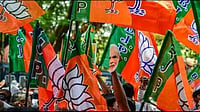The simmering political tensions in Ladakh over the past three years came to a boiling point and reached Delhi this month. Ladakhi leaders have formed a joint front to seek constitutional safeguards for the people of the strategically significant region.
Phunchok Stobdan, one of the top strategic analysts of India, says the Union Territory of Ladakh was not formed from an evolutionary political process but it was suddenly carved out of the erstwhile state of Jammu and Kashmir in August 2019. The phenomenon is throwing surprises, both internal and external, according to Stoban, who is a former Indian envoy to Kyrgyzstan and author of the book The Great Game in the Buddhist Himalayas
India and China’s Quest for Strategic Dominance.
In an interview with Outlook, Stobdan says there seems to be some shortcomings in the Union government's strategy of handling Ladakh that has resulted in the current situation. Edited excerpts:
What is your view on political agitation in Ladakh?
It started with the formation of the Union Territory (UT) of Ladakh. The UT has not emerged from a certain political evolutionary process. It emerged suddenly because of the 5th of August 2019 decision of abrogation of Article 370. Nobody was even aware of it. It was like it came down from the sky. Nobody got the time to analyse or weigh the pros and cons of what it meant and what the UT was all about.
Initially, they were jubilant, but slowly they realised their expectations were not met as the UT came without the provision of a legislature. A legislature would have made the Ladakhis masters of their own land. Their dream got shattered even though the demand for Ladakh to be declared as a UT is very old. It is older than Telangana. Since the 1950s, this demand to be directly ruled from Delhi was always there. But the way it came on August 5, 2019, was surprising. It fell short of their expectations.
Gradually, they also understood that it will hit their identity, demography, protection of land, jobs, etc. Thus, that initial euphoria turned into despair. It is also related to power. The creation of UT undermined pre-existing hill councils as all the powers shifted to the Lieutenant Governor and his administration which made the local councils feel powerless and disempowered. It was the loss of power that led two regions Leh and Kargil to project a united face against the government. The agitation started growing in 2020 and 2021 and moved on to gain momentum. And it got worse as it was never addressed.
Does the agitation have any impact on the already tense India-China situation along Line of Actual Control (LAC)?
The creation of Ladakh UT from J&K has two dimensions, internal and external.
Internally, you see there are political agitations both in Kargil and Leh to push their demands. There is a fear that the existing UT format will open the door for the influx of people from outside that would change the region’s demographic profile, identity, and protection of land and jobs, etc. When Ladakh was part of J&K, there were no such fears as Article 370 would protect the land and jobs of permanent residents.
Externally, China was rattled after Ladakh was separated from J&K and made into a UT. Together with Pakistan, China took the Ladakh issue to the UNSC after the creation of the Union Territory in August 2019. Then it pushed Indian troops along the Line of Actual Control. Rest we know what happened in Galwan Valley. Since then, the Chinese have been trying to rewrite their frontier history as well as building a narrative through social media and publications where they perceive Ladakh historically as part of Tibet. I guess the government’s conscious efforts to let the external influence grow in such a sensitive region may have also contributed to what is happening there.
Whereas Ladakh has been part of India since the Mughal period, it was Aurangzeb who actually protected Ladakh. In 1682, Ladakh could have otherwise gone to China or Tibet. The Qing dynasty attacked Ladakh in 1680. There was pushback because the Mughals gave a lot of support to local Ladakhi rulers. Nobody understands that Ladakhi association with Hindustan is 300 to 400 years old. It is not new or due to the Maharaja alone. Ladakh was well protected as part of India. So was Kashmir and so was Jammu. I am not saying the abrogation of article 370 was wrong. There are enough articulations and the Indian side of the narrative to counter the Chinese assertion. Leaving the matter in the hands of the armed forces seems not enough.
How do you see the protectionist demands of Ladakhi leaders?
You see, while in J&K, there is some sort of political process in the form of civil society, media, or intellectual debate, there has been nothing like that in Ladakh. Ladakhis just have a set of demands — full statehood, Sixth Schedule status, job reservations etc. These have become emotive issues and have set in peoples’ minds.
The BJP seems to be following its own ideological model distinct from the Congress’ model yielding to such demands. The current Ladakhi political standoff, therefore, is in conflict with the BJP’s ideology of “one country, one nation, and one law” based on the principle of equality. For example, Ladakhis are free to go and settle in any part of the country.
There seems to be a border security dimension as well. Some experts say that the Chinese have been infringing on Indian territories where there is no population. Many also argue that border areas remained unpopulated because the protectionist laws prohibited persons other than the locals to settle in such areas, which is not the case on the other side of border where Han people have been brought in to settle in Xinjiang and Tibet border areas — a reason why this government believes in removal of all protectionist safeguards.
Ladakhis have a counter-argument. They argue if the entire 2-3 lakh Ladakhi people go to Delhi, they are a drop in the ocean. If 10 lakh people come to Ladakh, 2-3 lakh locals would simply disappear. So they have logic in their argument. I think Ladakhis have opted for protectionist laws which are coming in conflict with the BJP ideology.
Is there any political strategy with the government to deal with political issues emerging from Ladakh?
I don’t think that the government, especially the current set-up in Leh, has enough experts to understand the nuances of Ladakhi politics, culture, and society. One of the most important parts of the J&K Notification Act of 2019 was that the Lieutenant Governor will be assisted by the advisors appointed by the Central Government. This has been evaded somehow. Accepted that LG is only a constitutional head, the provision of a political advisor would have served to assuage the problem.
How do you see Sonam Wangchuk’s argument that there are apprehensions in Ladakh that what China has done in Tibet, India will do the same in Ladakh?
I will not go that far. There is no room for comparison between the Chinese Communist systems with the Indian democratic system. What the Chinese are doing in Tibet is another subject. How can we compare that with Ladakh? We are a democracy.
You have been talking about increasing economic activity and trade. Do you think that is possible now?
Well, I have been talking about the connectivity and expansion of India’s economic outreach to the Eurasian continent —even up the Siberian region— for a very long time. After all, all the future strategic resources and rare-earth minerals lay in the continental Asia. India has been deprived of these resources due to either lack of access or due to inter-state border disputes.
Our attempts at connecting Eurasian land through the Persian Gulf —Chabahar Port— are not working well. Even the resources of our immediate regions of Xinjiang and Tibet are being completely exploited by the Chinese. I am not saying we should succumb to the Chinese for having trans-border connectivity and trade. All I am saying is that diplomacy is all about making things possible. One can say it is a border issue. China and Russia used to have border issues, so many countries have border issues but that doesn’t prevent the trade from flowing. Yes, I agree that the Chinese are dangerous. And once the routes are open they may exploit certain things but then we are creating so many security structures to deal with the threat.


























